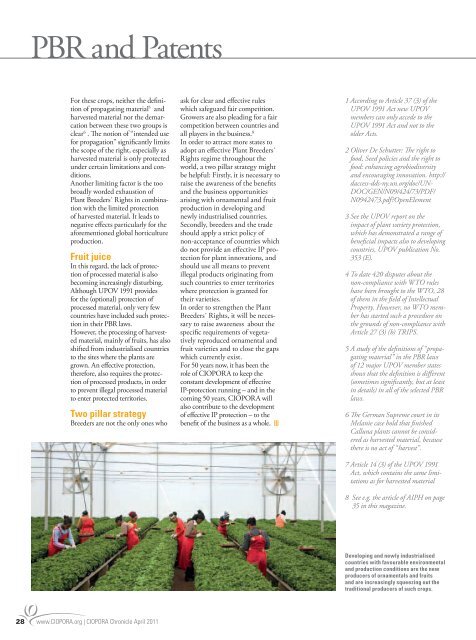2011 CIOPORA Chronicle - the 50th Anniversary Edition
CIOPORA annual magazine on Intellectual Property protection for plant innovations 2011. The magazine was produced in cooperation with FloraCulture International. Read in the 2011 CIOPORA Chronicle edition: - CIOPORA plays vital role in supporting the industry - PVR litigation on the rise - Plant Breeders´Right. Quo vadis? - China deploys national strategy for IPR - CIOPORA helps IP owners protect their rose varieties and much more...
CIOPORA annual magazine on Intellectual Property protection for plant innovations 2011. The magazine was produced in cooperation with FloraCulture International.
Read in the 2011 CIOPORA Chronicle edition:
- CIOPORA plays vital role in supporting the industry
- PVR litigation on the rise
- Plant Breeders´Right. Quo vadis?
- China deploys national strategy for IPR
- CIOPORA helps IP owners protect their rose varieties
and much more...
You also want an ePaper? Increase the reach of your titles
YUMPU automatically turns print PDFs into web optimized ePapers that Google loves.
PBR and Patents<br />
For <strong>the</strong>se crops, nei<strong>the</strong>r <strong>the</strong> definition<br />
of propagating material 5 and<br />
harvested material nor <strong>the</strong> demarcation<br />
between <strong>the</strong>se two groups is<br />
clear 6 . The notion of “intended use<br />
for propagation” significantly limits<br />
<strong>the</strong> scope of <strong>the</strong> right, especially as<br />
harvested material is only protected<br />
under certain limitations and conditions.<br />
Ano<strong>the</strong>r limiting factor is <strong>the</strong> too<br />
broadly worded exhaustion of<br />
Plant Breeders´ Rights in combination<br />
with <strong>the</strong> limited protection<br />
of harvested material. It leads to<br />
negative effects particularly for <strong>the</strong><br />
aforementioned global horticulture<br />
production.<br />
Fruit juice<br />
In this regard, <strong>the</strong> lack of protection<br />
of processed material is also<br />
becoming increasingly disturbing.<br />
Although UPOV 1991 provides<br />
for <strong>the</strong> (optional) protection of<br />
processed material, only very few<br />
countries have included such protection<br />
in <strong>the</strong>ir PBR laws.<br />
However, <strong>the</strong> processing of harvested<br />
material, mainly of fruits, has also<br />
shifted from industrialised countries<br />
to <strong>the</strong> sites where <strong>the</strong> plants are<br />
grown. An effective protection,<br />
<strong>the</strong>refore, also requires <strong>the</strong> protection<br />
of processed products, in order<br />
to prevent illegal processed material<br />
to enter protected territories.<br />
Two pillar strategy<br />
Breeders are not <strong>the</strong> only ones who<br />
ask for clear and effective rules<br />
which safeguard fair competition.<br />
Growers are also pleading for a fair<br />
competition between countries and<br />
all players in <strong>the</strong> business. 8<br />
In order to attract more states to<br />
adopt an effective Plant Breeders´<br />
Rights regime throughout <strong>the</strong><br />
world, a two pillar strategy might<br />
be helpful: Firstly, it is necessary to<br />
raise <strong>the</strong> awareness of <strong>the</strong> benefits<br />
and <strong>the</strong> business opportunities<br />
arising with ornamental and fruit<br />
production in developing and<br />
newly industrialised countries.<br />
Secondly, breeders and <strong>the</strong> trade<br />
should apply a strict policy of<br />
non-acceptance of countries which<br />
do not provide an effective IP protection<br />
for plant innovations, and<br />
should use all means to prevent<br />
illegal products originating from<br />
such countries to enter territories<br />
where protection is granted for<br />
<strong>the</strong>ir varieties.<br />
In order to streng<strong>the</strong>n <strong>the</strong> Plant<br />
Breeders´ Rights, it will be necessary<br />
to raise awareness about <strong>the</strong><br />
specific requirements of vegetatively<br />
reproduced ornamental and<br />
fruit varieties and to close <strong>the</strong> gaps<br />
which currently exist.<br />
For 50 years now, it has been <strong>the</strong><br />
role of <strong>CIOPORA</strong> to keep <strong>the</strong><br />
constant development of effective<br />
IP-protection running – and in <strong>the</strong><br />
coming 50 years, <strong>CIOPORA</strong> will<br />
also contribute to <strong>the</strong> development<br />
of effective IP protection – to <strong>the</strong><br />
benefit of <strong>the</strong> business as a whole. |||<br />
1 According to Article 37 (3) of <strong>the</strong><br />
UPOV 1991 Act new UPOV<br />
members can only accede to <strong>the</strong><br />
UPOV 1991 Act and not to <strong>the</strong><br />
older Acts.<br />
2 Oliver De Schutter: The right to<br />
food, Seed policies and <strong>the</strong> right to<br />
food: enhancing agrobiodiversity<br />
and encouraging innovation. http://<br />
daccess-dds-ny.un.org/doc/UN-<br />
DOC/GEN/N09/424/73/PDF/<br />
N0942473.pdf?OpenElement<br />
3 See <strong>the</strong> UPOV report on <strong>the</strong><br />
impact of plant variety protection,<br />
which has demonstrated a range of<br />
beneficial impacts also to developing<br />
countries, UPOV publication No.<br />
353 (E).<br />
4 To date 420 disputes about <strong>the</strong><br />
non-compliance with WTO rules<br />
have been brought to <strong>the</strong> WTO, 28<br />
of <strong>the</strong>m in <strong>the</strong> field of Intellectual<br />
Property. However, no WTO member<br />
has started such a procedure on<br />
<strong>the</strong> grounds of non-compliance with<br />
Article 27 (3) (b) TRIPS.<br />
5 A study of <strong>the</strong> definitions of “propagating<br />
material” in <strong>the</strong> PBR laws<br />
of 12 major UPOV member states<br />
shows that <strong>the</strong> definition is different<br />
(sometimes significantly, but at least<br />
in details) in all of <strong>the</strong> selected PBR<br />
laws.<br />
6 The German Supreme court in its<br />
Melanie case hold that finished<br />
Calluna plants cannot be considered<br />
as harvested material, because<br />
<strong>the</strong>re is no act of “harvest”.<br />
7 Article 14 (3) of <strong>the</strong> UPOV 1991<br />
Act, which contains <strong>the</strong> same limitations<br />
as for harvested material<br />
8 See e.g. <strong>the</strong> article of AIPH on page<br />
35 in this magazine.<br />
Developing and newly industrialised<br />
countries with favourable environmental<br />
and production conditions are <strong>the</strong> new<br />
producers of ornamentals and fruits<br />
and are increasingly squeezing out <strong>the</strong><br />
traditional producers of such crops.<br />
28 www.<strong>CIOPORA</strong>.org | <strong>CIOPORA</strong> <strong>Chronicle</strong> April <strong>2011</strong>









